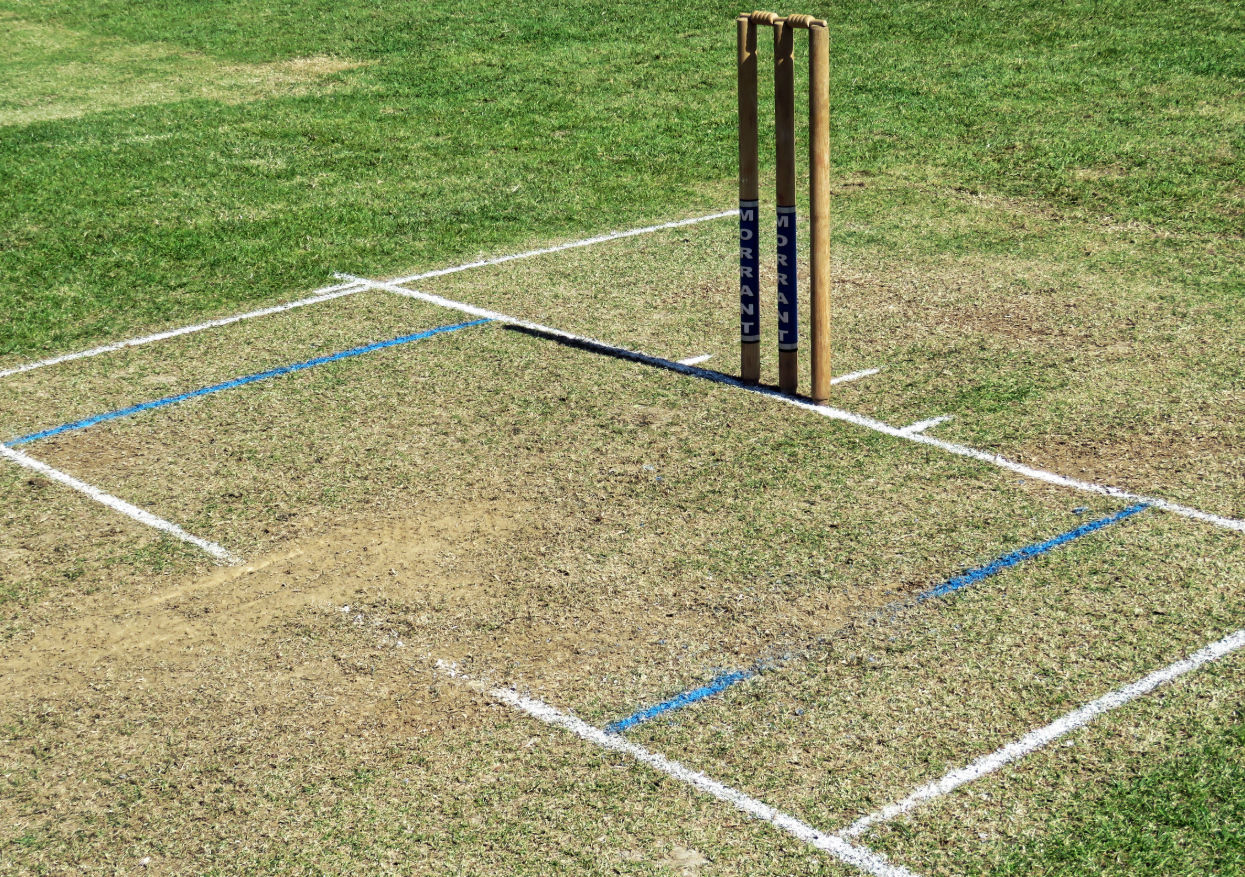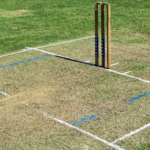Ever watched a cricket match and wondered what those white lines on the pitch actually mean? You’re not alone.
For new fans, the lines painted across the cricket pitch can look confusing. Some run horizontally, others vertically.
Batters seem to care deeply about staying behind them. Bowlers get penalized for crossing them.
And commentators keep mentioning “popping crease” and “bowling crease” without really explaining what they are.
If you’ve ever felt lost trying to understand these markings, this guide is for you.
How many creases are there in cricket? The answer is eight—but they’re just three types of lines repeated at both ends of the pitch.
Once you understand what each type does, the entire pitch layout suddenly makes sense.
How Many Creases Are There in Cricket?

Whether you’re watching IPL matches with friends, learning cricket basics, or trying to follow T20 games more closely, understanding creases will instantly make the game clearer.
Let’s break it down in the simplest way possible.
Also Check: Worst Pitch in Test Cricket History
What Exactly Is a Crease in Cricket?
A crease is a painted white line on the cricket pitch that marks specific zones for players and umpires.
Think of it like this: creases are cricket’s version of boundary lines. They tell batters where they’re safe from being run out.
They show bowlers where they must deliver the ball from. And they give umpires clear reference points for making critical decisions.
Without creases, cricket wouldn’t have the structure and fairness that make it such a precise sport. Every run-out, every no-ball, every stumping decision depends on these simple white lines.
Why Are They Painted Fresh Every Match?
Groundsmen repaint creases before every game because they fade quickly. Players run over them constantly, the ball hits them, and the weather affects visibility.
Fresh, bright lines ensure umpires can make accurate calls—especially during tight run-outs or close no-ball decisions.
In professional cricket, even a faded line can lead to controversies. That’s why you’ll see groundstaff meticulously marking every crease with white paint before play begins.
How Many Creases Are There in Cricket? The Complete Answer
Here’s the straightforward answer: there are eight creases on a standard cricket pitch.
Now, before that number sounds overwhelming, here’s the simple breakdown:
Three Types of Creases:
- Popping Crease
- Bowling Crease
- Return Crease
Repeated at Both Ends:
Each type appears at both ends of the 22-yard pitch. That’s why we get eight total creases.
Here’s the math:
- 2 Popping Creases (one at each end)
- 2 Bowling Creases (one at each end)
- 4 Return Creases (two at each end)
Total = 8 creases
This setup stays the same whether you’re watching Test cricket, ODIs, T20 matches, or IPL games. The rules are standardized globally by the Marylebone Cricket Club (MCC), cricket’s lawmaking body.
So when someone asks how many creases are there in cricket T20 or how many creases are there in cricket IPL, the answer is always eight. The format doesn’t change the pitch markings.
Quick Reference Table: All Cricket Creases Explained
| Crease Type | Quantity | Position | Main Purpose | Measurement |
|---|---|---|---|---|
| Popping Crease | 2 | 4 feet in front of stumps | Batter safety line & no-ball check | Parallel to the bowling crease |
| Bowling Crease | 2 | Directly under the stumps | Legal delivery mark for bowlers | 8 ft 8 in long (2.64m) |
| Return Crease | 4 | Vertical lines on both sides | Controls the bowler’s back foot | 8 ft 8 in apart |
This table gives you the essentials at a glance. Now, let’s dive deeper into what each crease actually does during a match.
The Popping Crease: Your Safety Line
The popping crease is probably the most important line on the pitch for batters. It’s the line that determines whether you’re safe or out.
Where Is It?
Located exactly 4 feet (1.22 meters) in front of the stumps at both ends. It runs parallel to the bowling crease—basically, it’s a horizontal line across the pitch.
What Does It Do?
For batters, crossing this line means safety. When running between wickets, you must get your bat or body grounded behind the popping crease to be considered “in.” If fielders remove the bails before you cross it, you’re run out.
The same applies to stumpings. If the wicketkeeper whips off the bails while you’re outside the crease, you’re dismissed.
The No-Ball Connection
Here’s where it gets interesting for bowlers. When delivering the ball, the bowler’s front foot must land behind the popping crease. If any part of their foot goes over the line, it’s called a no-ball.
A no-ball gives the batting team an extra run. In limited-overs cricket, it also often results in a “free hit”—meaning the next ball can’t get the batter out (except by run-out).
Real Example:
Remember when Ben Stokes bowled what seemed like a crucial wicket in a Test match, only for replays to show his front foot had marginally crossed the popping crease?
The wicket was overturned, the ball declared illegal, and momentum shifted completely. That’s the power of the popping crease.
Cricket Crease Length in Feet:
The popping crease extends indefinitely across the pitch width—there’s no specified endpoint. But its distance from the stumps is always 4 feet.
The Bowling Crease: Where Everything Begins
The bowling crease is the foundation line of the pitch. It’s where the stumps stand, and it marks the delivery zone for bowlers.
Where Is It?
Right underneath the three stumps at each end. It runs perpendicular (at a right angle) to the pitch direction.
What Does It Do?
This crease defines the legal delivery area. Bowlers must ensure their back foot lands within or touches this line during delivery. The stumps are positioned exactly along this line.
Length Matters
The bowling crease is exactly 8 feet 8 inches long (2.64 meters). This measurement is standard worldwide, ensuring consistency across all cricket grounds.
Why It’s Critical
While the popping crease catches no-balls from the front foot, the bowling crease works together with return creases to control the bowler’s back foot placement. If a bowler’s back foot goes outside the return creases (which extend from the bowling crease), it’s a no-ball.
Positioning the Stumps
The three wooden stumps are centered on the bowling crease. The middle stump sits exactly in the center, with the other two positioned 4.5 inches apart on either side. This precise placement ensures fairness for bowlers and batters alike.
The Return Crease: The Forgotten Guardian
Most fans focus on the popping and bowling creases, but the return crease plays a crucial role too—especially for bowlers.
Where Is It?
Unlike the other two, return creases run vertically (up and down) rather than horizontally. There are two at each end of the pitch, one on either side of the stumps.
They extend from the bowling crease at right angles, running alongside the pitch.
What Does It Do?
The return crease controls where a bowler’s back foot can land during delivery. The back foot must land inside or touching these vertical lines. If it lands outside, the delivery is illegal—resulting in a no-ball.
This rule prevents bowlers from delivering the ball from extreme angles that would give them an unfair advantage.
How Wide Are They?
The two return creases at each end are 8 feet 8 inches apart—the same as the bowling crease length. They form a box-like zone within which the bowler must operate.
Why It Matters
Imagine if bowlers could deliver from anywhere—far to the left or right of the stumps. It would be nearly impossible for batters to predict the angle. The return crease keeps bowling fair and consistent.
Real-Life Impact
During tense matches, umpires carefully watch bowlers’ back foot placement. Even experienced bowlers sometimes stray outside the return crease in their follow-through, resulting in costly no-balls.
How Many Creases Are There in Cricket India, IPL, and T20?
This is a common question because fans wonder if different formats or leagues change the rules.
The answer: No difference whatsoever.
Whether you’re watching:
- Test cricket in England
- T20 matches in the IPL
- ODI games in Australia
- Local cricket matches in India
The number and type of creases remain the same: 8 creases total (2 popping, 2 bowling, 4 return).
- How many creases are there in cricket in India? Eight.
- How many creases are there in cricket IPL? Eight.
- What about Cricket 24 (the video game)? Even in EA Sports’ Cricket 24, the virtual pitches replicate real-world cricket laws—so yes, eight creases.
The Laws of Cricket, governed by the MCC, standardize these measurements globally. This ensures that whether you play street cricket in Mumbai or Test cricket at Lord’s, the fundamental pitch markings stay consistent.
Why Creases Matter During Live Play?
Understanding creases isn’t just academic—they directly affect match outcomes.
For Batters:
Every run requires crossing the popping crease safely. During close run-outs, even inches matter. Batters slide their bats across the line, dive desperately, and sometimes lose their wicket by millimeters.
For Bowlers:
Staying within legal boundaries is constant pressure. A single overstep can turn a wicket-taking delivery into a free hit for the opposition. Bowlers practice their run-ups endlessly to land perfectly behind the popping crease.
For Umpires:
Creases provide clear, visible reference points for critical decisions. Modern cricket uses technology like ball-tracking and slow-motion replays, but umpires still rely heavily on crease markings for instant calls.
For Fielding Teams:
Smart fielders target the creases during run-outs. Players like MS Dhoni became legendary partly because of their ability to break stumps before batters could cross the line—often by fractions of a second.
Memorable Crease Moments in Cricket History
1. MS Dhoni’s Lightning Reflexes
Dhoni’s run-outs often came down to pure speed and precision. In countless matches, he’d whip off the bails before batters could ground their bats behind the popping crease—sometimes by margins so small that third umpires needed multiple replays.
2. The 2019 World Cup Final
Perhaps cricket’s most dramatic finish. England vs New Zealand came down to a super over after a tied match. Multiple run-outs and stumpings were reviewed frame-by-frame. Every inch of the popping crease mattered. The outcome literally hinged on whether batters had made it behind the line.
3. No-Ball Controversies
Over the years, several major wickets have been overturned because replays showed the bowler’s front foot had marginally crossed the popping crease. These moments often shift entire match momentum—turning celebrations into devastation within seconds.
Common Questions About Cricket Creases
- Can a Batter Be Safe If Their Bat Is ON the Line?
No. The bat or body must be grounded BEHIND the line, not on it. Even touching the line while the bails are removed means you’re out.
- Do Groundsmen Paint Creases Differently for Different Formats?
No. The markings stay identical whether it’s a five-day Test or a three-hour T20. Only the pitch preparation (grass length, moisture) varies by format.
- What Happens If a Bowler Crosses the Return Crease?
Instant no-ball. The batting team gets an extra run, and in limited-overs cricket, usually a free hit follows.
- Why Are Creases Always White?
White paint provides maximum contrast against green grass or brown pitches, making them easily visible to players, umpires, and TV cameras.
- How Accurate Are Crease Measurements?
Extremely precise. Before international matches, officials verify every measurement. Even a half-inch error could affect gameplay, so ground staff use specialized measuring tools.
Types of Creases in Cricket: Summary
Let’s recap the types of creases in cricket one more time:
Popping Crease:
- The batter’s safety line
- 4 feet in front of stumps
- Determines run-outs, stumpings, and bowling no-balls
Bowling Crease:
- The baseline where stumps stand
- 8 feet 8 inches long
- Marks the legal delivery zone
Return Crease:
- Vertical lines on both sides
- Controls the bowler’s back foot placement
- Prevents extreme angle deliveries
Together, these three types (repeated at both ends) create the eight creases that structure every cricket pitch worldwide.
Frequently Asked Questions
- How many creases are there in cricket?
There are eight creases total: 2 popping creases, 2 bowling creases, and 4 return creases (two at each end of the pitch).
- What is the bowling crease in cricket?
The bowling crease is the horizontal line underneath the stumps where bowlers deliver the ball. It’s 8 feet 8 inches long and marks the legal delivery zone.
- What is the return crease in cricket?
Return creases are the vertical lines on both sides of the stumps. They control where a bowler’s back foot can land—stepping outside results in a no-ball.
- How long is the popping crease from the stumps?
Exactly 4 feet (1.22 meters) in front of the stumps. This distance is standardized globally.
- Do T20 and IPL matches use the same creases?
Yes. All formats—Test, ODI, T20, and IPL—use identical crease markings. The Laws of Cricket are universal.
- What happens if a bowler crosses the popping crease?
It’s called a no-ball. The batting team gets an extra run, and in limited-overs formats, often a free hit follows.
- Can a batter be out if their bat is on the line?
Yes. The bat or body must be grounded behind the line, not on it. Touching the line while the bails are off means you’re out.
- Why are creases repainted before every match?
They fade quickly from constant foot traffic and weather. Fresh markings ensure accurate umpiring decisions, especially during close calls.
Final Thoughts: Why Those Lines Matter
Next time you watch cricket, pay attention to those white lines. Notice how batters desperately lunge for the popping crease during tight run-outs.
Watch how bowlers carefully place their feet during delivery strides. See how umpires instantly glance at crease positions when making calls.
How many creases are there in cricket? Eight total—but now you know they’re more than just painted lines.
They’re the invisible referees that keep cricket fair, strategic, and endlessly dramatic.
Understanding creases transforms you from a casual viewer into someone who truly appreciates the game’s fine margins. And in cricket, margins make champions.








